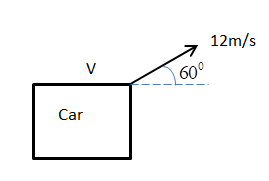
A railway flat car, whose mass together with the artillery gun is ${\text{M = 2m,}}$ moves at a speed V. The gun barrel makes an angle $\alpha = {60^0}$ with the horizontal. A shell of mass m leaves the barrel at a speed $\nu = 12m{s^{ - 1}},$ relative to the barrel. Find the speed of the flat car ${\text{V}}\left( {{\text{in m}}{{\text{s}}^{ - 1}}} \right)$ in order that it may stop after the firing.
Answer
591.9k+ views
Hint: To solve this question, we will use the concept of conservation of momentum of a system. Since the net external force on the system (car and shell) is zero along the horizontal direction. Therefore the momentum of the system before and after the firing will be the same.
Complete step-by-step solution -

Given that the speed of the shell is $\nu = 12m{s^{ - 1}}$ and the angle that gun makes with the horizontal is $\alpha = {60^0}$
Let V be the speed of the system (car and shell of mass 2m) before the action.
And since after the firing the car stopped i.e. speed (momentum) of the car = 0
And mass of the system is ${\text{M = 2m}}$
Now we will calculate the speed of the shell w.r.t ground = speed of the system $ + $ speed of the shell along the horizontal direction
$ = V + 12\cos {60^0}$
According to the conservation of momentum
Momentum of the system before firing = momentum of the system after firing
$
\Rightarrow MV = 0 + (V + 12\cos {60^0})m \\
\Rightarrow 2mV = V + 12 \times \dfrac{1}{2} \times m \\
\Rightarrow mV = 6m \\
\Rightarrow V = 6m/s \\
$
Note- To solve these types of questions, remember the concept of conservation of momentum and also remember if along a certain direction external forces on the system is zero then the work done by it is only due to internal forces so the external effect of the system remains unchanged.
Complete step-by-step solution -

Given that the speed of the shell is $\nu = 12m{s^{ - 1}}$ and the angle that gun makes with the horizontal is $\alpha = {60^0}$
Let V be the speed of the system (car and shell of mass 2m) before the action.
And since after the firing the car stopped i.e. speed (momentum) of the car = 0
And mass of the system is ${\text{M = 2m}}$
Now we will calculate the speed of the shell w.r.t ground = speed of the system $ + $ speed of the shell along the horizontal direction
$ = V + 12\cos {60^0}$
According to the conservation of momentum
Momentum of the system before firing = momentum of the system after firing
$
\Rightarrow MV = 0 + (V + 12\cos {60^0})m \\
\Rightarrow 2mV = V + 12 \times \dfrac{1}{2} \times m \\
\Rightarrow mV = 6m \\
\Rightarrow V = 6m/s \\
$
Note- To solve these types of questions, remember the concept of conservation of momentum and also remember if along a certain direction external forces on the system is zero then the work done by it is only due to internal forces so the external effect of the system remains unchanged.
Recently Updated Pages
Why are manures considered better than fertilizers class 11 biology CBSE

Find the coordinates of the midpoint of the line segment class 11 maths CBSE

Distinguish between static friction limiting friction class 11 physics CBSE

The Chairman of the constituent Assembly was A Jawaharlal class 11 social science CBSE

The first National Commission on Labour NCL submitted class 11 social science CBSE

Number of all subshell of n + l 7 is A 4 B 5 C 6 D class 11 chemistry CBSE

Trending doubts
What is meant by exothermic and endothermic reactions class 11 chemistry CBSE

10 examples of friction in our daily life

One Metric ton is equal to kg A 10000 B 1000 C 100 class 11 physics CBSE

1 Quintal is equal to a 110 kg b 10 kg c 100kg d 1000 class 11 physics CBSE

Difference Between Prokaryotic Cells and Eukaryotic Cells

What are Quantum numbers Explain the quantum number class 11 chemistry CBSE




